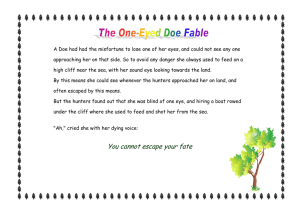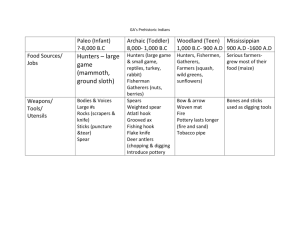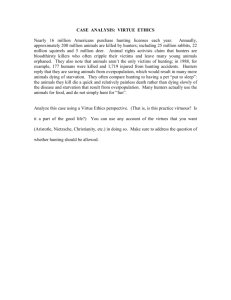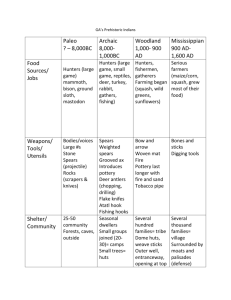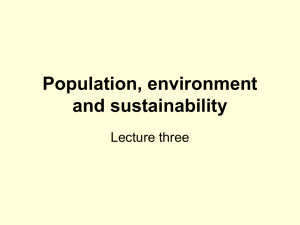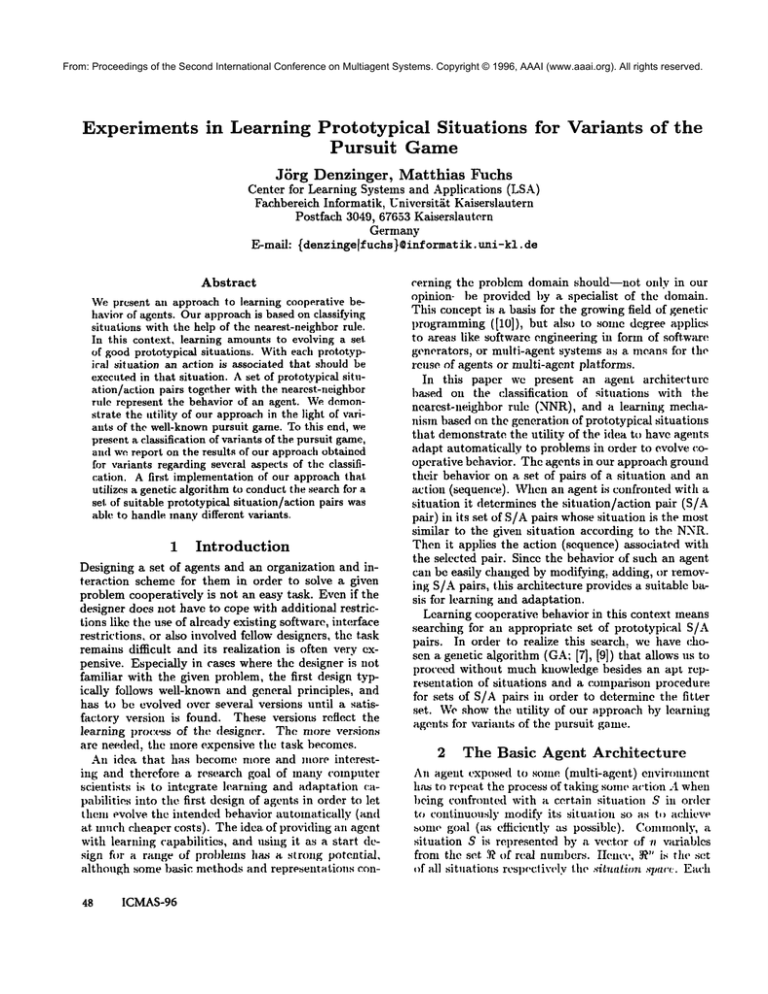
From: Proceedings of the Second International Conference on Multiagent Systems. Copyright © 1996, AAAI (www.aaai.org). All rights reserved.
Experiments in Learning Prototypical
Situations
Pursuit
Game
JSrg Denzinger,
Matthias
for Variants of the
Fuchs
Center for Learning Systems and Applications
(LSA)
Fachbereich Informatik, Universit~t Kaiserslautern
Postfach 3049, 67653 Kaiserslautern
Germmly
E-mail: {denzingelfuchs}@informatik.uni-kl.
de
Abstract
Wepresent an approach to learning cooperative b.ehavior of agents. Our approach is based on classi~’ing
situations with the help of tile nearest-neighbor rule.
In this context, learning amounts to evolving a set.
of good prototypic’dd situations. With each prototypical situation an action is ,associated that should be
executed in that situation. A set of prototypicaa situation/action pairs together with the nearest-neighbor
rule represent the behavior of an agent. We demonstrate the utility of our approazh in the light of variants of the well-known pursuit game. To this end, we
present a classification of variants of the pursuit game,
and wc report on the results of our approach obtained
for variants regarding several aspects of the classification. A first implementation of our approach that
utilizes a genetic algorithm to conduct the search for a
set. of suitable prototypical situation/a~tion pairs was
able to handle many different variants.
1 Introduction
Designing a set of agents and an organization and interaction
scheme for ttmm in order to solve a given
problem cooperatively is not an easy task. Even if the
designer does not have to cope with additional restrictions like the use of already existing software, interface
restrictions,
or also involved fellow designers, the task
remains difficult
and its realization
is often very expensive. Especially in cases where the designer is not
familiar with the given problem, the first design typically follows well-known and general principles,
and
has to be evolved over several versions until a satisfactory version is found. These versions reflect the
learning process of the designer.
The more versions
are needed, the more expensive the task becomes.
An idea that has become more and more interesting mid therefore
a research goal of many computer
scientists
is to integrate learning and adaptation (’apabilities into the first design of agents in order to let
them evolve tim intended behavior automatically
(and
at much cheaper costs). The idea. of providing an agent
with learning capabilities,
and using it as a start design fi)r a range of problems has a strong potential,
although some basic methods and representations
con48
ICMAS-96
cerning the problem domain should--not
oidy in our
opinion- be provided by a specialist
of the donlain.
This concept is a basis for the growing field of genetic
progralnming ([10]), but also to some degree applies
to areas like softwa.re engineering in form of software
generators, or multi-agent systems as a. means for the
reuse of agents or nmlti-agent platforms.
In this paper wc present an agent archite(’turc
ba.~ed on the classification
of situations
with the
nearest-neighbor
rule (NNR), and a learning
mechanism based on the generation of prototypical situations
that demonstrate the. utility of the idea to have agents
adapt automatically to problems in order to evolve cooperative behavior. Thc agents in our approach ground
their behavior on a set of pairs of a situation and an
action (sequence). When all agent is confronted with
situation it determines the situation/action
pair (S/A
pair) in its set of S/A pairs whose situation is the aiost
similar to the given situation
according to the NNR.
Then it applies the action (sequence) associated with
the selected pair. Since the behavior of such an agent
can bc easily changed by modi~’ing, "adding, or removing S/A pairs, this architecture provides a suitable basis for learning and adaptation.
Learning cooperative behavior in this context means
searching for an appropriate
set of prototypical
S/A
pairs. In order to realize this search, we have chosen a genetic algorithm (GA; [7], [9]) that allows us
proceed without much knowledge besides an apt representation
of situations
and a comparison procedure
for sets of S/A pairs in order to deternfine the fitter
set. We show the utility
of our approach by learning
agents for variants of the pursuit game.
2 The Basic
Agent
Architecture
An agent exposed to sonm (multi-agent)
enviromnent
has to repeat the process of taking some action A when
being confronted with a certain situation
S in order
to continuously nlodify its situation so as t,~ achieve
borne goal (a.s efficiently
as possible).
Commonly,
situation S is represented by a vector of n variables
from the set .~ of real nuinbcrs. IIcncc, ~" i,~ the set
of all situations respectively the sit’ant.ion spare. Each
From: Proceedings of the Second International Conference on Multiagent Systems. Copyright © 1996, AAAI (www.aaai.org). All rights reserved.
component xi of a situation S = (xi,...,x~)
G .~"
essentially expresses a certain feature of S. Given ‘4
as the set of all possible actions (respectively action
sequences) an agent may take, the behavior of an agent
is reflected by its strategy @: ~’~ --* 04 that allows the
agent to select an action ~(S) = A G 04 when being
confronted with situation S.
There are many ways to realize the behavior of an
agent, i.e.,
a mapping from ~" to 04. We propose
here to utilize a finite, non-emptyset 5[ -- {(Si, Ai)
~’~ x ,4 I 1 < i < m~r} of prototypical S/A pairs
as basis for an agent’s behavior. Given a situation
S E .~", an agent takes the action Aj which is associated with the situation Sj--i.e.,
(Sj, Aj) E :£-.
that is closest (respectively the most similar) to
among all situations in I. More precisely, we employ a distance measure Z) : ~" x ~’~ --* ~ (typically the Euclidean distance measure that we also exnployed for our experiments). Given the minimal distance 6,~in - min({T)(Si,S) I 1 < i < rnz}) between
situations S; in 2: and the given situation S, the action selected by strategy @z is ~r(S) Aj, wherc
j = rain({1 < < 1 9(s , s) = is the smallestindex of situations in Z that axe closest to S. (The
smallest index is chosen merely to resolve ambiguities.)
Approaches based on the NNRfascinate with their
simplicity. Nevertheless (or because of that) they
have shown considerable success in connection with
instance-based learning ([1]) and classification problems (e.g. [141/. Applications of the NNRcommonly
involve a set 2" which is (a subset of) a set of given
training examples. Weintend here to evolve the set I
with the help of a GAin order to optimize the performance of an agent employing strategy ~:r. Since
evolution can be equated with search, the GAis only
one among many search methods that can be utilized.
Wechose the GA, because it has practical and theoretical properties that suit our approach. Alternative
search methods can be investigated in future research.
Regardless of the search method employed, the basic
architecture or design of a strategy determines (a) how
good a strategy we can expect to find and (b) howdifficult the search is going to be. Point (a) surely favors
the use of neural nets, because a neural net can realize (almost) any mapping provided that it is equipped
with an apt topology and the connection weights are
chosen appropriately. But evolving weight configurations and possibly also evolving net topology is a strenuous task even for the GA(cp. [21]). Considering the
fact that neural nets are "over-sophisticated" for many
applications, simpler designs entailing more manageable search spaces are called for. Similar considerations
apply to genetic programming([10]).
Classifier systems ([7]) can---by design-profit from
the GAmuch more easily. Also, they are a very powerful methodology. But the rather complex architecture
of a classifier system and the sophisticated techniques
involved (e.g. credit assignment, bidding, etc.) make
worthwhile thinking about simpler methods, in particular in connection with problems that do not require
the fldl powerof a classifier system.
The use of condition/action rules is a very popular
approach in this context {e.g., [611. Commonly,such
a rule is of the form "if al _~ Xl ~ bl A ... A a~
x~ < b,~ then execute A G 04", where each condition
ai <_ xi < bi specifies the range of values for variable xi
(w.r.t. this rule). In a set of rules, the rules are (implicitly) or-connected. Hence, such a set of rules can
subdivide the situation space ~’~ into hyper-rectangles
which are aligned with dimension axes. These hyperrectangles may be partially overlapping, which calls
for disambiguation techniques, and there may be gaps
that necessitate somekind of default rules.
The major limitation of these condition/action rules
is the restricted way they can subdivide the situation
space. An approach based on a set of prototypical S/A
pairs and the NNRas described above allows for subdividing the situation space without overlapping and
gaps, where the possible sub-spaces include, but are
not limited to hyper-rectangles. As a matter of fact,
such an approach can piecewise-linearly approximate
arbitrary sub-space boundaries.
In [20], both approaches are combined. But the GA
is only applied to evolve sets of condition/action rules,
which then provide the NNRbased component with
S/A pairs. Wecouple here the GA and the NNRapproach tightly, meaning that the GAis immediately
responsible for the set 2: of S/A pairs.
Before presenting the details of the GAdesigned for
our approach, we would like to elnphasize the simplicity of our approach: Oncethe situation spax:c is known,
the fundamental "data structure" is a situation respectively a point in the situation space and an associated
action. Hence, the basic architecture of a strategy.
namely a set of such S/A pairs--is at least as easy to
handle (by a GA)as a set of condition/action rules,
though more expressive.
3 Learning
with
the
GA
The preceding sections repeatedly pointed out that
we intend to evolve respectively search for a strategy (behavior) ~z respectively a finite set 2: of S/A
pairs. So, the search space we have to cope with is
the set of all finite sets of S/A pairs. Even if we limit
the number of S/A pairs of each set I to some arbitrary but fixed 1 < ME [N, i.e., rnz < M for all
Z = {(Si,Ai) [ 1 < i < mr}, the search space in general remains enormous (and unstructured). The use
a GAappears to be appropriate under these circumstances, because the GAhas the potential to cope with
intricate search spaces in the absence of any knowledge
about their structure. Furthermore, a GAis less prone
to getting trapped in a local optimum. Both properties are highly valuable for our purpose. In the sequel..
we describe the basics of the GAin the light of our
application.
Denzinger
49
From: Proceedings of the Second International Conference on Multiagent Systems. Copyright © 1996, AAAI (www.aaai.org). All rights reserved.
Unlike other search methods, the GA m~fintains a
set of (sub-optimal) solutions, i.e., several points
th,’ search space. In this context, a .-.ohttion is prefertrbly cMlcdan individual, and the whole set is referred
to as a population or generation. Usually, the size of
the popuhttion is fixed. In order to explore the search
~pace, the GAapplies so-called gent:tic operators to
(a subset of the) individuals of its current population.
’riffs way, new individuals (,an be created and hence
new points in the search space (’an be reached. In order to keep the polmlation size fixed, it must be determined which individuals are to be eliminated in order
to make room for the new ones. For this purpose a
so-called fitness measure is employed which rates the
fitness (i.e., the ability to solw: the problemat hand)
each individual of the current population. The genetic
¢H)erators are applied to the most fit. individuals, this
way producing offspring which then replaces the lea,st
tit individuals ("survivM of the attest").
So, the GAbasically proceeds its follows: Starting
with a randomly generated initial population, the GA
repeats the cycle comprising the rating of all individuals using the fitness measure, applying the genPlic {)per~Ltors to the best individuals, and replacing the worst
individuals with offspring of the best, until someternlina.tion conditionis slttisfied (e.g... an individual witt,
a satisfactory fitness level hmsbeen (’reated).
In our ease an individual 27 corresponds to a strategy represented by a (finite) set of S/A ptfirs. The
fitness of an individual is assessed in terms of the
problenl solving expertise of its associated strategy ff2z.
The fitness measure is the only connection be.tweon the
GA as an underlying search method and the actual
problem. Therefore, we cannot define a specific titness
measure at this point, and we have to postpone details
until a concrete, problemis specified (see section 5).
The initial population of the GAis (as usual) generated completely at random. That is, for each individual 2- of the initial population comprisingn j,, n, individuals, both its size mz < 3I and the mz S/A pairs
iLre dcternfined at random.
Two genetic operators are employed here, namely
crv~ssove.r and mutatior,. (’Reproduction’ as given by
[10], for instance, is basically realized by the survival
of the r% fittest individuals.) Ottspring is produced
through crossover, while mutation can modify this oilspring. Tim crossover operator randondy selec.ts two
distinct parents from the pool of r% best (surviving)
individuals. A subset of the S/A pairs of e~u’]t parent in(lividual is chosen at random, and the union of
these two subsets yields the "child" individual. (Note
that the surviving individuals here simply all hawr an
equal chance to become reproductiw~.)
The mutation operator modifies individuals stemming fi’om
crossover before they are admilted to the next gen(,ration. An individual 77 is subject to mutation with
probability P,,,~t- If an individual :/7. actually is selected
for mutation, each S/A pair of Z is--with probalfil50
ICMAS-96
ity P,.,,treplaced
by a randomly generated pair.
4 The Pursuit
Game
In order to demonstrate the potential of our approach
to learning cooperating agents we. need proldents l ltal
require different degrees of coopt:ration and different
behavior of agents. But these prolflems als,~ haxe t,
be easy to understand (which does nol imply that
they can be solw,d oasily as well), and shc,uhl allow
fi~r (’~mtparisons regarding several criteria, e.g.. contplexity, necessary cooperation or solubility. Therefore
it wouhl he best to have one basic prol)h.m that allows
for varia.nts regarding several aspects.
Fortunately. there is such a basic problem, namely
the so-called pursuit game 0dso called "’huntor and
prey") that wa.s first presented in [2]. Since then,
numberof quite different approaches to solving this basic problem(see, for examl,h,. [17], [12])and also sont,.
variants (sec [51, [18], [191) have1,een i,roi,,,s,,d , s,, that
the pursuit game can be called the "1)locks w~wkl"~f
the DAI community.
The basic problem can I)e described ~mfi)lh)ws: There
are four hunler agents (also called predatt,rs) and
prey agent on an infiifite rectilinear grid. The gain(’ is
played in discrete time steps. At each time sl.ep, an
agent (’an II’I()VP t)lle Sqllil.re a lmrizontal tH’ vertical
direction, or stay put. The prey selects its steps randomly. The hunters win the game, if they can surround
the pre.y. No two agents lnay occupy the same square.
The task is to develop a. strategy for the lmnters that
enabh,s them to win the game.
There are several tmpects of this basic scenario thai
can Im varied. In the following we will take a closer
h~ok at all ~mpects, and we will examine more closely
some combinations of several ~Lspects that eft her have
been investigated in literature or will be inw,stigated
in section 5.
1. The form of the grid
In the basic scenario the grid-world h;Ls no I~oundaries and there arc no obstlu’h,s in it. Variants regarding this ;u~pect can be created by introducing
boundaries (e.g., a N x N grid) t,r obstacles (with
varying shapes).
2. The individual
hunter
In the basic scenario a hunter agent does m)t have
many features.
Therefore one can obtain v;u’iants
with respect to the following sul)-asl)et:ts:
a) Sh.tq~e and size
A hunter may not only occupy one square t,f tit,,
grid, lint several ~f them. It nukv be quadratic.
but it can also ha.re other shapes.
b) Possible moves and actions
Besides moving~mly in the vertical or h~,rizontal
direction (or not movingat all) vari~mts c;m include diagonal mow.sor turns (rotations). if lurns
actually haw, an effect. Therecan alsc~ I,. communit’aticm actions (see d)).
From: Proceedings of the Second International Conference on Multiagent Systems. Copyright © 1996, AAAI (www.aaai.org). All rights reserved.
c)Speed
A hunter
doesnothaveto be as quickas theprey.
It canbe faster,
butit canalsomovemoreslowly
thantheprey.
d) Perception and communication capabilities
An aspect that greatly influences the strategy of
a hunter (and therefore each solution attempt for
the game) are its perception and communication
capabilities.
(Note that being able to see the
other hunters is a kind of visual communication.)
The spectrum of this aspect ranges from hunters
with no or very limited communication capabilities to hunters utilizing sophisticated communication methods.
e) Memorycapabilities
An aspectthat can becomeimportantif the
hunters
areableto communicate
witheaz.hother
is the memoryof an agent.Memoryallowsan
agentto remember
plansandintentions
of other
hunters.Theremay be no memory,a restricted
sizeforthe memory,or an arbitrary
amountof
memory.
.
The hunting team
For most variants of the game more than one hunter
(and cooperation between the hunters) are required
so that there is a chance to succeed. Therefore, the
composition of the team of hunters is also an aspect
that can be varied.
a) The number of hunters
For each combination of the other aspects there is
a minimal number of hunters needed to win the
game. Deploying more hunters may help to win
the game, but mayalso require different, possibly
more sophisticated strategies and more effort in
developing these strategies.
b) The type of the hunters
Since there can be different types of hunters (according to aspect 2), quite different strategies--.
depending on what kind of hunters form the
team.--are needed to cooperate in order to win.
4. The prey
The prey is an agent like the hunters.
same sub-aspects a) to e) apply with
that communication is only necessary
several prey agents (as was suggested
there is aa additional sub-aspect:
Therefore the
the exception
if there are
in [13]). But
f) The strategy o/the prey
The (escape) strategy of the prey is the main factor determining the difficulty to win the game.
Strategies range from simply moving in one direction (which can be quite successfld, see [8]) over
random moves to elaborate strategies like maximizing the distance from the nearest or all hunters.
Even learning strategies to counter those of the
hunters was suggested and tried out (with perhaps
too muchsuccess, see [8], again).
5. The startsituation
Thestartpositions
of bothhunters
andpreycanalso
influence
boththepossibility
to winthegameand
theeffort
forlearning
a cooperative
strategy
forthe
hunters.
If thegameis alwaysstarted
fromthesame
positions
and no randomelementis introduced
by
otheraspects,
thena winning
strategy
willalways
win(andis easierto learn).
Otherwise,
different
startsituations
willleadtodifferent
outcomes.
6. The goal
Evenforthe definition
of if and whenthegameis
won thereare two variants.
The mainquestion
is
to "capture"
or to "kill".
The preyis captured
if
it cannotmoveto anothersquareanymore
(i.e.,it
is totally
surrounded
by boundaries,
obstacles
and
hunters).
It iskilled
if thepreyanda hunter
occupy
thesamesquare(at somepointin time).The goal
mayalsoinclude
resource
limitations.
Fordescribing
anactual
variant
of thepursuit
gameit
is necessary
to choose
oneof thepossible
instantiations
for each aspect and sub-aspect, Obviously: the possibilities to win are quite different for different variants.
Most of the work regarding the pursuit game so far
centered on strategies for particular variants that were
developed by human beings, naturally with some emphasis on the cooperation (using communication)
the hunters. In [18] and [19] the authors concentrated
on communication-intensive strategies for the hunters.
Diagonal moveswere presented in [11]. (See aLso [15].)
But variants of the pursuit game were also used as a
testbed for approaches to learning cooperative agents.
In [8] a genetic programmingapproach was applied to
variants originating from variations of the escape strategT of the prey. Even experimental data concerning a
co-evohltion of hunters and prey was provided. Genetic programming results in programs that are more
expressive than our approach, but more expertise on
the parts of the designer is required, because not only
a suitable representation of situations must be found,
but also the building blocks of programs(functions and
terminals) must be chosen properly.
Another work dealing with learning cooperative behavior and the pursuit gameis described in [13]. There,
a genetic algorithm approach was chosen to learn
strategies for variants with n + 4 hunters and n prey
agents (where n was varying). In contrast to our approach, in [13] a genetic algorithm is used to search
good parameters for a program that includes memory
and planning functions. Hence, this approach does not
provide as high a level of abstraction as our S/A pairs.
5 Experiments
Thissectiondocuments
theexperimental
settingand
theresults
we obtained
withourapproach
forseveral
variants
of thepursuit
game.In orderto describe
the
setting
wehaveto describe
howtorepresent
situations,
actions,
and--for
thelearning
part--we
describe
the
fitness
measure
19 oftheGA.
Denzinger
51
From: Proceedings of the Second International Conference on Multiagent Systems. Copyright © 1996, AAAI (www.aaai.org). All rights reserved.
5.1
Representing
Situations
and Actions
The representation of situations is the maiu factor that
,h, termine.s whether suitable agent strategies can b(’
learned, how good they will be, and how difficult the
learning process will 1)ecome.Clearly.. there art.’ difre.rent representations even for a single variant of the
pursuit game, and also dearly we havr to expect that
,liffcrent variants need quite different representations.
In fact, the representation is the only possibility for a
designer to influence the evolving strategy (which w~u
exactly our goal).
In our experiments we have chosen to use representations for situations that differ as little as possible
from variant to variant (which kind of emulates an unexl)erienced designer and puts quite a burden on our
learning appro~:h). Due to this reason (I)ut also
to lack of space and due to the efficiency of our implementation that can only be seen as a first, very crude
version) we restricted our experiments to only a few ,ff
the aspe,’ts of section 4. These aspects are the strategy of the t)rey., start situation, goal, possible nmves.
number of hunters, and perception capabilities.
All
other aspe(:ts werr fixed: There is just one prey. All
k _> I hunters arc of the same type, i.e., they occupy
OllO square, have the sanlc possible IItOV{~S~ nlove at the
sam(: speed as the prey (one moveper time unit),
lutve no me.morycapal)ilities.
The prey always knows
the. position of all hunters, and in most exl)eriments we
us[.d a 30 x 30 grid. Furthermore: we de,’.ided to hay,,
all hunters use the same strategy ~I (which is reas,)md)h, because the hunters are not ,listinguishabk0.
Thus, learning amounts to searching for one suitable
set LT of prototypical S/A pairs.
Our basic representation of a situation is based on
the positions of the agents regarding a distinguished
reference square (0,0) employing the usual Cartesian
coordinate system. IIunter i occupies squa.re (.r~, y~)
7/ x 7] and the prey occupies square (x,y) 7/ x7/.
(7/is the set of all integers.) V~recharacterize tim situt~tion of hunter i with the help of its relative positkms
regarding prey and fellow hunters. That is, the situation ,Yi of hunter i is a vector consisting of :r. -x,, y- yi
and, if the hunters see: their fellow hunters, xj -.r,,
Y.I-Yi for 1 <_ j _< k (i # j) sorted according t,)j.
Hcn(’e, the situati, mSlmCeis 7/2k.. or 7/2 if the hunters
see only the prey. (On a N×Ngrid, 7/can be restricted
to {-N + 1 ..... N - 1}. See ~flso l-t].) This representation can Im enhanced with hunter types, hunter
oricntatkm (if it is not quadratic), coordinates of obsta(’les, and memoryfields (for more information ,.m
olher hunters or for history information). Th,, possiI)lr movesfor both hunters and prey are either N. S, E,
Wor stay put, or these moves plus the diagonal mow~s
NE, NW,SW, and SE. (If communication actions are
l)ossiblc, thcy also have to be added.) Ihmters mid
prey execute their moves simultaneously. (Sec [4] for
details on conflict resolution.)
In our experiments, the possit)le instantiations for
52
ICMAS-96
the varying aspects are: Tim lmntors tither set, each
other mid tim prey, or only th,, prey. (Thus we have
to establistx COOl)erationwithout "proper" COIlllllUIlit’alion; see [16].) The start situation is either fixed (prey
in the center of the 30 x 31} grid, ]mntrrs lined up along
tim whole western l)oundary with equal distancc from
each other; a single hunter starts fronl the lniddle of
the western boundary), or chosen at random (prey
the center, each hunter at least 5 squares awayfron, it
in both horizontal and vertical directior,). These start
positions art Msoused in case of an infinite grid, lint
naturally the grid bom,daries are ignored after setting
up the initial situation. The goal situations are killing
or capturing the prey. The number of hunters is tit,,
minimalnulnl)er that is required to win the gamt, (theerotically). (If hunters see felh)w hunters, we always,leploy k _> 2 hunters.) There will also Im some remarks
on the effect of additionM hunters in subsecti(m 5.3.
Finally, thrrc ,,re five escape strategies ~1 ..... ~b:,.
Note that, t,, our knowlcdge, ~.1 and Cr, art’ n0jvel.
In particular 05 proved to Im quite chalh,nging (cp.
subsection 5.3) Besides precluding movestlLitt violate
seine rules or restrictions, the prey also d, ws n,)i consi,h,r movesthat lead to a squarr ¢’llrrently
o,’¢’upie,l
by a hunte.r, ~dthoughtilt, llunl,(.r mighl movea.way
from that squarr. The remaining ntow,s are referrrd
to im eligil,le
moves. Each escape strategy (exrept
fi)r 02) centers ou a different vector of distance values
(dl .... , din), rtt .> 1.. that reflects the currrnt situation
of the prey from it certain l)oint of view. Conmlonto
all thes(, stratrgi,rs is that th(. pre.y tri~s out (sinmlales)
all eligible movt,s and tholl picks the best move(h,sl.rd
first.). Distance vectors art.: comparedusing the usuM
lexi(’ographic ,)rdering >l,.,. (loft-t,~-right (’omlmrison
with >), where "greater" means "l)~.ttrr’.
If diagonal
movesare allmved, then th,’ basic distance nteasurr is
thr Euclidean distance. Tit(’ "’Manlmtl.an distance" is
rml)loye, I ol]mrwis,,. In the sequel, lrt di be t],,’ basic
distance, botwotmprey aud hunter i.
~t: AlaMmizt, d/stance fi’om n,,are,st hunter: m = 1.
di :"- rain({dl ..... ,I.,. }).
~b2: RandomItlOVelIH’lit:
AnlOllg all eligible lnf~v(~S tile
preychoosesoneitlOV(, ~.11. r~,lll(lolll.
Slayingput is
not an eligibh’ mow~hrre. C,msoqnelttly, the prey
d,)es not stay put unless traplmd.
(I,:,:
Maximizesum ,f distances h’om all hnn t,ws: m=
1. dt :-- ,II + ..... [-cl,x..
’1’4:Ahtximizrvc(’t,n" of sorrt,d distanc(, vMu,,s: m.= k,
(dl ..... d~.) is ,,btained In" sorting dt ..... dr. s,,
thal
di "~ d,_l.
@r.: Es(’almstrategy g,-, is m, ext.rnsion of ~.i. In ad(lition to dj,.... ~It.: the prey here als, tak,,s into
accountits smal]est(listall(’e froln t.~tt’h of th,, four
grid I)ound~ries. Consequently, m. = L: + 4. By
,flso trying to mmximizetit(’ distam’r from grid
],,mndari,.s. escalmslratogy ff)a alhwiates a "tlnw"
From: Proceedings of the Second International Conference on Multiagent Systems. Copyright © 1996, AAAI (www.aaai.org). All rights reserved.
of escape strategy ~4 which (like ~1 and ~3) essentially makes the prey run away to some grid
boundary where it can be captured or killed much
more easily than it can be when trying to stay
in "open field" as long as possible. (Obviously,
~s cannot be applied to an infinite grid-world.)
5.2
The Fitness
Measure
The fitness measure ~ is to rate the performance of an
individual I, i.e., a set of S/A pairs. The performance
of I is given by the suitability of the associated strategy ¢Yr employed by each hunter. In case random effects can occur, it is clear that the fitness cannot be determined reasonably
basedon merelyonetrial(hunt).
Consequently,
several
trialshaveto be executed,
and
theoutcomes
of theseelementary
fitnessvaluesmust
be combined
to obtaintheoverall
fitness
0.
The elementary fitness measure0 rates a single trial.
0 should therefore reflect if the hunters were successful
in that particular trial, and in that case, howfast they
succeeded. In case of failure, 8 should somehowexpress
how close to success the hunters came. Naturally, the
hunters cannot be granted an arbitrary amount of time.
If they do not succeed within T = 200 time steps: then
their hunt is judged a failure. The elementary fitness
measure 0(~) E IN is defined as follows.
success
in t~ < T steps
0(z)=E(=l
~’~i=,
6(i,t),incaseoffailure,
where~(i,t) is theManhattan
distance
thatseparates
hunteri fromthepreyat timestept. Hence0(2")
thesmaller
thefitter
2?isconsidered
to be.
Theoverall
fitness
4(I)ofZ iscomputed
ina straight
forward way on the basis of b > 1 trials which result
in b elementary fitness values 01(I),..., 0b(27):
1
b
= o,(z).
i=l
If no random effects occur, we set b = 1, and b = 20
else. An individual I is considered as being successful
only if all b trials were successful. If two individuals
have the same overall fitness measure, then the more
concise individual is preferred.
For our experiments, the parameters of the GAwere
chosen as follows (cp. section 3): r = 30%, P,~t
50%, P~nd = 10%, npop = 100. The maximal number Mof S/A pairs of an individual 27 was restricted
to 30. (All these settings were determined after a few
preparatory experiments and are in no sense "optimal".) The maximal number of generations (cycles)
of the GAwas limited to 100. The GAstopped before
exceeding this limit as soon as a successful individual
was found. For each ~triant of the pursuit game the
GAwas run 5 times, and the performance of the best
individual that surfaced in (one of) these 5 runs is presented. This ’best-of-5’ policy is reasonable, because
experiments corroborated that several shorter runs are
more pronfising than a single long run (cp. [10]). (We
picked the number ’5’ more or less arbitrarily.)
For
details on the performance of the GAsee [4].
5.3
Results
Tables 1-4 present the core of our experimental results
for a 30 x 30 grid. (Wewill also report on other experiments that do not fit into these tables.) Each table and
its caption specify the particular variant of the pursuit
game. The column labeled with ’k: shows the number
of hunters. The columns labeled with 200, 1000, 10000
display the performance of the ’best-of-5’ individual
when granted the respective number T of time steps.
(Note that T = 200 during learning.) The performance
is given as the numberof steps necessary to succeed if
no randomeffects can occur, and as a success rate that
was determined based on 100 trials otherwise.
Being granted more time steps T only pays off in connection with random escape strategy ~2- There, the
hunters essentially chase the prey, waiting for the prey
to make a certain sequence of moves that allows them
to succeed. Naturally, the probability for this to happen increases with the number of time steps. However,
by allowing diagonal and hence more moves, this probability decreases, which is reflected by the sometimes
significant worse performance of the hunters whendealing with a prey using ~ and diagonal moves comparcd
to the case where no diagonal moves are allowed. For
all other strategies, failure is almost always caused by
some kind of "deadlock", so that increasing T does not
improve the success rate.
Tables 1 and 2 show that the theoretically minimal
number of hunters "almost always suffice to succeed
respectively to achieve an acceptable success rate (if
granted sufficient time) even though the huntcrs only
focus on the prey (emergent behavior). The only significant failure (0% success rate) occurs when2 hunters
starting from random positions attempt to capture the
prey that tries to escape using either &3 or ~4, and
diagonal moves are not allowed (see table 2). With
3 hunters the success rate is ca. 100%in both cases.
From a theoretical point of view it is clear that
hunters that see both prey and fellow" hunters are at
least as versatile as hunters that see only the prey.
But taking into account fellow hunters enlarges the
situation space and thus complicates the search space.
This is the main reason why we sometimes obtained
worse results in practice although better results have
to be expected in theory. Nonetheless, considering
fellow" hunters sometimesleads to significant improvements (possibly because it is indispensabh:). This happened, for instance, in connection with the case discussed above where 2 hunters focusing on the prey had
a success rate of 0%; 2 hunters that also see each other
performed significantly better (cp. tables 2 and 4).
could makethis observation again whentackling a variant related to the original version of the pursuit game.
Only 4 hunters hunting a prey using ~2 on an infinite
Denzinger
53
From: Proceedings of the Second International Conference on Multiagent Systems. Copyright © 1996, AAAI (www.aaai.org). All rights reserved.
Table 1: Hunters see only the prey, and their objective is to :’kill".
Fixed Start Positions
RandomStart Positions
No Diagonal Moves
Diagonal Moves
No Diagonal Moves
Diagonal Moves
q) k 200 1000 10000 k 200 1000 10000 k 200 1000 10000 k 200 1000 10000
(I)1
2 33 33 33 2 28 28 28 2 100% 100% 100% 2 11~)% 100% I00%
~2 1 100% 100% 100% 1 100% 100~ 100% 1 96% 99~: 100% 1 99% 100’/c 100%
28
2 28
28
(I)3
28
28
28
2 100% 100% 100% 2 100c~: 100% 100%
44
44
44
2
28
28
28
2 100~ 100% 100% 2 99% 99% 99%
~4 2
54
54
2 26
26
26
2 99% 99% 99% 2 ]00% 100% 100~:
~.5 2 54
Table 2: Hunters see only the prey, and their objective is to :’capture".
Fixed Start Positions
RandomStart Positions
No Diagonal Moves Diagonal Moves No Diagonal Moves
Diagonal Moves
(b k 200 1000 10000 k 200 1000 10000 k 200 1000 10000 k 200 1000 10000
2 56 56 56 3 28 28 28 2 100% 100% 1(}(}c~
-3 96% 96% 96%.
2 55% 100% 100% 3 5% 22% 72% 2 10~. 81% 100% 3 3% 37% 92%
2 56 56 56 3 28 28 28 2 0% 0% 0% 3 100% 100% 100%
2 59 59 59 3 33 33 33 2 0% 0% 0% 3 88~:.
88% 88’~.
grid that see each other achieved an acceptable success rate (55e/0 when being granted 10000 time steps
and starting from fixed positions).
Furthermore, a prey using the quite sophisticated escape strategy q% appears to be very hard to capture.
First of all, a prey using ~s tries to stay away from
I,oundaries and corners. As a matter of fact. it cannot
be forced to move into a corner or next to a boundary in any way. Consequently.. 4 hunters arc required
to capture the prey if diagonal movesare not allowed
(8 hunters else). In our experiments, 4 hunters only
succeeded when they knew about their fellow hunters.
(See [4] for more details.)
We’also examinedthe effects a surplus of hunters can
have. On the one hand, it is understandable that more
hunters have a better chance to win the game. On
the other hand, due to the fitness measure, all hunters
will chase the l)rey and hence might hinder each other..
in Imrticular when they only focus on the prey. (In
order to favor more sophisticated pursuit strategies inwflving "driving" and "ambushing" the fitness measure
has to be adapted appropriately.) In our experiments,
increasing the number of hunters (up to 7) (lid
haveany significant
negative effects (except for complicating the search space if fellow bunters were to be
considered, of course).
6 Discussion
Wehave presented an approach for learning COOl)erative behavior of reactive agents th~a is based on the
search for a set of prototypical situation/action p~firs.
An agent employs the nearest-neighbor rule to select
that tntir whose prototypic~d situation is closest (most
similar) to the actual situation, and then performs the
~Lssociated action. In our current implementation, tim
search is conducted by a genetic algorithm.
54
ICMAS-96
Our goal was tt, demonstrate that this approach is
considerably versatile in that ii allows a designer of
multi-agent systems to specify requirements on a. very
high level in terms of ;,. represeI,tation of situations
and possible actions (and a comparison of strategies in
our case), and then a satisfactory soluti,m i~ evolved
autcmt~LticMiy. Wecould show that this goal can be
achieved in many cases: Wepresented aspects of the
well-knownpursuit ganmthat (’art be varied so a.s to
obtain wtriants of the game, and for many of these
(non-trivial) variants the first implenmntatkm,)f
approach succeeded in evolving apt strategies.
However,Ollr experiments also sugK(,sted several improvements. Although it was surprising hc~w well
our ad hoc inq~lementation of the genetic algorithm
l)erformed, for In’el lems involving a. mor,, CCmll)lex
representation of situations inlprovenlelltS
art’ necG~ssary. The use of additional knowledge (apa.rt from
the knowledgeintegrated with the fitness nlc’asure),
alternative search methods (possibly t’ombint’d with the
genetic algorithm), and enhanced efficiency
tim)ugh
distributed search seem to be. profitabh,. Tht. TEAMWOI~K
approach to distributed search ([3]) is c~,pable
of achieving these goals, nevertheless providing a high
level of at)stra,’tion for the designer.
A coral)arisen c,f our aplmn,.ch with otlt(’r
tie,ruling) approaches fi, connection with the pursuit game is
a.t the time rather difficult, because other .’l.pl)roaches
mostly have been examinedwith respect t.~ a fi,w particular variants of the game. Moreow,r, in most cases
the experimental setting cannot be reproduc:ed, because full information on all aspects of the game is
not availabh~. But this is essential in order t~, ~,bt.ain a
rr~liable coinl)aris(,n, because(;Ls our experin,e~,ts have
shown) tiny variations of the setting can have significant effects.
From: Proceedings of the Second International Conference on Multiagent Systems. Copyright © 1996, AAAI (www.aaai.org). All rights reserved.
Table 3: Hunters see both prey and fellow hunters, and their objective is to "kill".
Fixed Staxt Positions
Random Start Positions
No Diagonal Moves
Diagonal Moves
No Diagonal Moves
Diagonal Moves
67 k 200 1000 10000 k 200 1000 10000 k 200 1000 10000 k 200 1000 10000
28
671 2 29
29
29
2 28
28
2 100% 100% 100% 2 100% 100% 100%
2
100%
100%
99%
100%
100%
100%
2
2 96% 100% 100% 2 100% 100% 100%
672
28
28
28
28
2 28
2 78% 78% 78% 2 98% 98% 98%
673 2 28
42
42
2 28
28
28
2 82% 82%
82% 2 99% 99% 99%
674 2 42
182 2 26
26
26
2 74% 74% 74% 2 100% 100% 100%
182
675 2 182
Table 4: Hunters see both prey and fellow hunters, mad their objective is to "capture".
Fixed Start Positions
Random Start Positions
No Diagonal
Moves Diagonal
Moves No Diagonal
Moves Diagonal
Moves
67 k 200 1000 10000 k 200 1000 10000 k 200 1000 10000 k 200 1000 10000
671 2 56 56 56 3 30 30 30 2 83% 83% 83% 3 74% 74% 74%
672 2 53% 100% 100% 3 4% 18% 88% 2 50% 100% 100% 3 1% 3% 21%
673
2 57 57 57 3 28 28 28 2 11% 11% 11% 3 81% 81% 81%
674 2 61 61 61 3 28 28 28 2 99% 99% 99% 3 81% 81% 81%
References
[1] Aha, D.W.; Kibler, D.; Albert, M.K.: InstanceBased Learning Algorithms, Machine Learning 6, 1991
V.; Dodhiawalla,
R.:
[2] Benda, M.; Jagannathan,
An Optimal Cooperation of Knowledge Sources, Technical Report BCS-G2010-28, Boeing AI Center, 1985
[3] Denzinger, J.: Knowledge-Based Distributed Search
Using Teamwork, Proc. 1 *t ICMAS,San Francisco,
CA, USA, 1995, pp. 81-88
[4] Denzinger, J.; Fuchs, M.: Experiments in Learning Prototypieal Situations for Variants of the Pursuit Game, Technical Report LSA-96-04E, University
of Kaiserslautern,
1996, access via WWW
at http://
w~w. uni-kl,de/AG-AvenhausMadlener/fuchs,
html
[5]Gasser,L. ; Rouquette,N. ; Hill, R.W. ; Lieb,
J.: Representing and ,,sing organizational kno~dedge
in DAI systems, in Distr. AI, vol 2 of Research Notes
in AI, Pitman, 1989, pp. 55..-78
J.J.: Lamarckian Learning in Multi[6] Grefenstette,
agent Environments, Proc. 4th International Conference on Genetic Algorithms, 1991, San Diego, CA,
USA, pp. 303-310
[7] Holland, J.H.: Adaptation in natural and artificial
systems, Ann Arbor: Univ. of Michigan Press, 2~d edition, 1992
D. ;
[8] Haynes, T. ; Sen, S. ; Schoenefeld,
Wainwright, 1~.: Evolving Multiagent Coordination Strategies with Genetic Programming, submitted to Artificial
Intelligence,
access via WWW
at
http ://euler.
mcs.utulsa,edu/’haynes/jp,
ps
[9] De Jong, K.: Learning with Genetic Algorithms:
Overview, Machine Learning 3:121--138, 1988
An
[10] Koza, J.R.: Genetic Programming: On the Programming of Computers by Means of Natural Selection:
MIT Press, Cambridge, MA, 1991
[11] Korf, R.E.: A simple solution to pursuit games,
Working Papers of the 11th Intern. WSon DAI, 1992,
pp. 195-213
[12] Levy, R. ; Rosensehein, J.S.: A Game Theoretic
Approachto Distributed Artificial Intelligence and the
Pursuit Problem, in Decentralized AI III, Elsevier,
1992, pp. 129-146
good
[t:}] Manela, M. ; Campbell, J.A.: Designing
pursuit problems as testbeds for distributed AI: a novel
application of genetic algorithms, Proc. 5t~’ MAAMAW,Neuchatel, 1993, pp. 231-252
[14] Miehie, D.; Spiegelhalter,
D.J.; Taylor, C.C.:
Machine Learning, Neural and Statistical
Classification, Ellis Horwood, 1994
[15] Osawa, E.-I.: A Metalevel Coordination Strategy for
Reaetfi~e Cooperative Planning, 1"t International Conference on Multi-Agent Systems, 1995, San Francisco,
CA, USA, pp. 297-303
[16] Rosenscheln~ J.S. ; Ginsburg, M. ; Genesereth,
M.R.: Cooperation Without Communication, Proc.
AAAI-86, AAAI-Press, 1986, pp. 51-57
[17] Singh, M.P.: The effect of agent control strategy on
the performance of a DAI pursuit problem, Working
Papers of the 10th Intern. WSon DAI, 1990
[18] Stephens, L.M. ; Merx, M.B.: Agent organization
as an effector to[ DAI system performance, Working
P~pers of the 9 Intern. WSon DAI, 1989
[19] Stepheus, L.M. ; Merx, M.B.: The effect of agent
control strategy on the performance of a DA] pursuit
problem, Proc. 1990 Distributed AI V/orkshop, 1990
S.L.: Combining the
[2(}] Sheppard, J.W.; Salzberg,
Genetic Algorithm with Memory-Based Reasoning,
Proc. 6’h International Conference on Genetic Algorithms, 1995, Pittsburgh, PA, USA
[21] Zhang, B.-T.; Milhlenbein, H.: Genetic Programruing of Minimal Neural Nets I/sing Occam’s Razor,
Proc. 5ta International Conference ou Cenetic Algorithms, 1993, pp. 342-349
Denzinger
55

